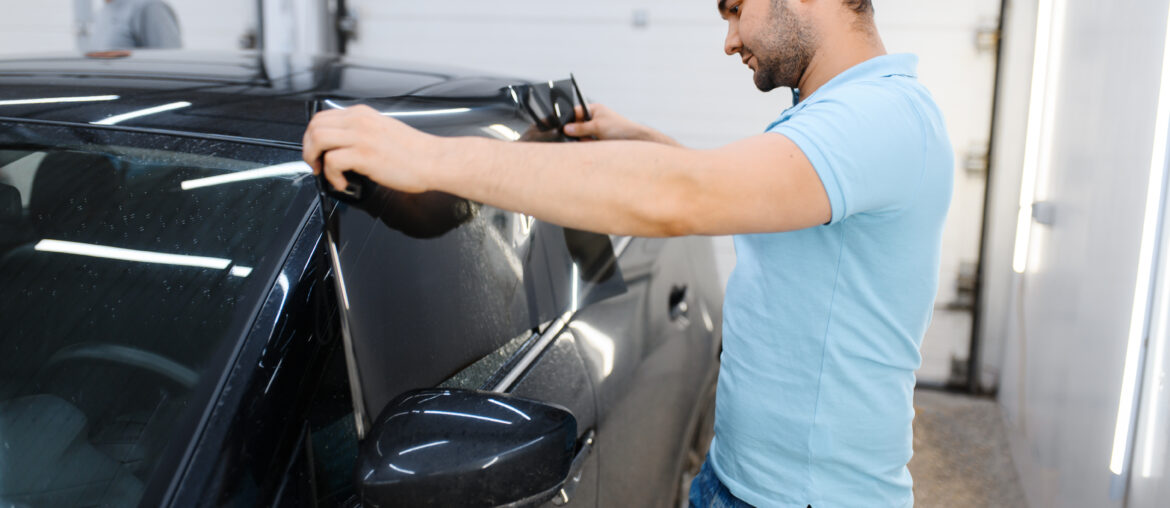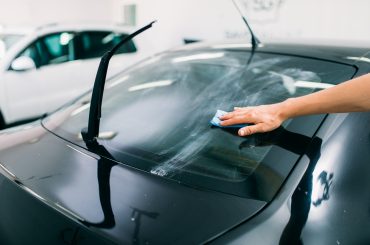If you are wondering how to tint car windows to get the best look and highest protection, then this article is for you! Most people are attracted to the idea of getting a stylish look on their vehicle. Even though this is the main reason that someone would want to have tinted windows, there are other aspects that should also be considered related to health and safety issues. Always make sure to get the best product in terms of safety that fits your budget. You can research the different types by referring to our article on Types of Window Tint.
When tinting your car windows, you can either seek professional guidance or choose to Do It Yourself (DIY), which might be a more cost-effective option. But still, there might be pros and cons of these methods. So let us provide you the most important facts and other details about how car windows are tinted professionally, and introduce you to some DIY techniques.
Table of Contents
Benefits of Tinting Car Windows
Apart from stylish looks and blocking UV radiation, there are even more advantages of having window tints on your car. A detailed description is provided in chapter Benefits of Car Tint in our article Types of Window Tint.
Let’s try to figure out the benefits of tinting car windows briefly.
- One of the best benefits you can get from tinted windows is reduced glare on your eyes. If you are living in a tropical country, you would most likely buy a vehicle with already tinted windows or get them tinted as soon as you buy the car. Reduced glare on eyes makes you feel comfortable while driving and indirectly, reduces road accidents.
- Tinted windows have the ability to reflect heat energy back to the surrounding and allow only a part of light rays to enter the vehicle. Therefore, the interior of your vehicle would be cooler and physically comforting.
- An added advantage of less heat inside the vehicle is that the inner parts of your vehicle would not be damaged or discolored. This would reduce the vehicle depreciation with time.
- The film of window tint would also protect the glass from damage. In any case of the windows brushing against some leaves or branches, the glass would not get scratched directly. Depending on the type of tint used, the film of tint may get scratched or completely stay undamaged in such cases.
- Tint films are able to block harmful UV and IR radiations from penetrating into the vehicle. The efficiency of this differs depending on the type of car tint. The ceramic tint is considered to be the best radiation blocking type of tint available at present.
- Since unwanted heat and harmful radiation are blocked, it would create a reduction of risk on the health of the travelers. It would prevent eye infections such as cataracts and also reduce the risk of getting skin cancers.
- Privacy and safety are a direct benefit of using window tint. Since the interior of your car would not be clearly visible from the outside, you would experience more privacy even during driving or stopping by traffic. You can also leave your things inside the car without any fear of theft, as the visibility inside is blocked.
- Some types of car window tints such as metalized tint, carbon tint, and ceramic tint increase the strength of glass due to their tight arrangement of particles on the film. Therefore, the glasses would not be broken easily.
- Even though the window glasses are broken due to a very high impact, some types of tint create a shatter-free mechanism on the window. Ceramic tint is a very good example of this.
- This can also help to increase the value of your vehicle when selling if you have a proper and efficient window tint installed on it.
How are Car Windows Tinted Professionally?
Most of the vehicles come with factory-tinted glass which is done at the stage of manufacturing. People might think that this is enough and you are good to go driving. But this may not be the ideal case, because the factory-tinted windows offer only very limited protection for yourself and the interior of your vehicle. So, it is always better to get your car windows tinted professionally.
Factory tinted glass is a standard film of tint applied to most of the new SUV vehicles and trucks. The process of this installation is called “deep Dipping”, where the glass is dyed with a dark pigment. Due to the varying legal restrictions in different states and countries, the vehicle manufacturers only add a very low VLT of about 15% to 26%. It is also applied only to the rear window and the side windows are left unprotected. Hence, this would not be enough to keep away the harmful radiation from your vehicle.
Why are the Advantages of Getting Professional Help?
Getting a professional window tint done is the best option for premium protection. They always know what would be the best type of window tint, depending on your budget, lifestyle, and usage of the vehicle.
Professional installation of window tints is done by qualified and certified technicians who have had hands-on experience for a long period of time. Hence, the accuracy of proper installation would be very high and you do not need to worry about the process and outcome. They would do the application on the glass so carefully that air bubbles would not get trapped inside, like when you do it yourself. The professionals would also create a custom pattern for different vehicles using advanced technological computers and equipment.
Factory specifications are always followed by professionals and you do not need to worry about causing any damage to your windows during the procedure. A quality installation is guaranteed with a perfect fit and finished look. So, it is always good to let the professionals handle the task for you. In the meantime, you can sit back and relax, knowing well that your windows would look amazing after it’s done. If something goes wrong on a later day, you always have the option of taking it back and getting it fixed by them.
Nevertheless, if you are worried about the excess cost of going for professional help, then you still have the option of trying the Do It Yourself methods. It would save you the extra cost and also get you a novel experience in trying out a new task all by yourself. So, let’s find more about this.
How to Tint Car Windows
DIY Methods to Tint Your Car
DIY windows tint kits are available at your ease. You can get them from various supermarkets or hardware stores. The price of average window tints would vary within a range of $100 to $400. If you buy a very cheap tint for your car, it would be easily observed by the people in addition to the low protection it has. So, choose a product that would last long for months or years. You would never get disappointed by spending some extra money on the quality.
Always make sure to buy a tint that comes with a warranty. Else, the film would easily be cracked and peeled due to low quality. Offering a warranty shows that the manufacturers are confident about their product. Therefore, you too can use the product without any hesitation. Try a trending and popular brand when choosing the window tint for your car. Do some research and come up with a good brand before you buy or make your order online.
There are three main types of application methods depending on the type of tint you use. They are:
- Coating Tint
- OEM Tinted Glass
- Film Tint
The installation of the Film Tint will be discussed in this.
What you need
- A film of window tint – make sure to follow the instructions of the manufacturer when transporting and storing the film so as not to damage them
- Film application solution – usually, this comes along with the film and it is recommended to use the same solution in the application.
- A razor blade/ knife – used to cut out the film along the edges of the window.
- Scraper blade – used to remove any adhesive on the glass prior to application.
- A cloth – used for cleaning the window glass
- Hard-edge – used in pressing down the film along with the glass and tucking it into the seals
- Heat gun – used to heat up and increase the adhesiveness of the film.
Prepare the windows
- Clean and dry the workplace and make it free from any dust, because dirt and dust would easily get mixed with the tint.
- Then, remove any existing stickers, adhesives, or patches of glue marks left on the windows.
- Next, use a razor blade, some soapy water, or some glass cleaner to clean the glasses foe effectively. Using a spray bottle is highly recommended.
- Then dry the windows clean using a dry rag. Make sure to remove the dirt in all places, even under the seals.
- Keep the car windows up at the beginning of the installment. As you would need to roll down the windows later, it is better to leave the car on.
Cutting and Preparing the Tint
- Get the film of tint, find the adhesive side. Make sure that the plastic that needs to be peeled off is facing you, at the start of this procedure.
- Spray some soapy water outside the window. This would help the tint to get adhered temporarily while the slippery nature of soap would help in making adjustments to get the film in place.
- Place the window tint film on the outside of the window in such a manner to cover the whole area of the glass. This is just for getting the measurements correct. Do not remove the plastic or paste yet.
- Now since you have got an idea about the required dimensions of the window, cut a manageable piece off the roll of film. This would make it easy for you to handle the film hen pasting. Make sure to have a few extra inches of the film in all directions from the frame of the window.
- Place the film over the window and spray water on the front of the film.
- Hold the film firmly over the glass and cut along the left edge and the bottom of the window. You can easily do this by tracing a knife along with the frame, over the film. Make sure that the film does not move during cutting.
- Next, pull the film about an inch towards the left side that you just cut. This is to make sure there is enough film to cover the glass when you cut the remaining sides.
- Now cut the right edge and slide the film a bit back to the center, which was drawn to the left in the previous step.
- Pull down the film about one inch. Now the film should be nit longer than the bottom edge of the frame.
- Roll down the window by about half an inch. Then cut the top part of the film into the proper shape of the glass.
- Pull the film a bit up and now you must have a film of tint that is about half-inch extra than the window frame on all the sides.
- Cut out any unwanted corners of the film. Adjust the film again to fit the glass perfectly, with excess length on all sides.
Adhering the Tint
- Use a heat gun to blow hot air on the film, while pushing a hard card from top to bottom. Press and make the film smooth on the outside of the window. Push down all the air bubbles stuck in between the glass and the film. Keep repeating this and run the heat gun along the bottom edge of the glass to dry out all parts equally. Now the tint would be stuck on the outside window.
- Prepare the inside of the window in a similar way to the outside. Clean the inside of the window and spray some soapy water using a spray can.
- Now get back to the film that you pasted on the outside of the window and peel half of the release liner plastic down. Do not rip it off completely.
- Now you have an exposed section of tint. Spray some water over it using a spray can.
- Repeat the same for the inside of the window as well. But when pasting the film over the soapy glass, make sure to insert the edges of the film underneath the seal. Sneak the edges into left and right, to make sure that the glass is fully covered with film.
- Once again, push down the water and air bubbles using your hard edge. Here, make sure to squeeze out the water from the top and sides, but not towards the bottom. It is because the rest of the liner should still be pasted at the bottom.
- Roll up the window and spray some soapy water on the bottom of the window.
- Pull out the remaining part of the release plastic and spray water on the freshly exposed tint as in step 4 of this section.
- Tuck the film of tint to the edges of the seal using a hard edge.
- Smoot out the glass using the hard edge by pushing out the water and air bubbles. Now you have a well-finished tint on your car window.
How Much Does it Cost to Tint Car Windows?
In general, the cost might fluctuate between $25 and $200 or more per window. The cost of window tinting would vary mainly, depending on whether you choose to do it yourself or seek professional guidance. The price will also vary on the number of windows that you choose to tint and how big the windows are. The cost will also depend on the type of warranty they offer. Various countries have varying prices depending on the markets.
The prices would also vary depending on the type of film you choose to use. The cost can be arranged from the highest to lowest, in the order of ceramic tint, carbon tint, metalized tint, hybrid tint, and dyed film tint respectively. The prices would differ depending on the type of vehicle and few examples can be given as follows.
- Sedans will have a price of $50 per window if a more affordable type of tint is chosen. The lowest price would be$250 for all seven glasses. However, this could even be at a price of $100 per window for a more expensive type of tint and the lowest price would be $650 for all seven windows.
- The coupe model has steep or curved windows and would cost more. Since it is more challenging, the cost of labor would be high and the average range would be $120 to $450 for five windows.
- Trucks might need additional time and labor due to the size. On average, it would cost around $350 to tint the windows.
- SUV modeled vehicles would cost around $250 to $750 for window tinting.
What to Consider Before Getting Started?
Before getting started, you might need to consider the quality and warranty of the product. Identifying the various types of tint available is a major requirement before making any decision. You can refer more to this by referring to our article on Types of Window Tint.
You can also start off by carrying out research based on a proper comparison between the types of car window tints. After identifying the most prominent varieties from the article linked above, you can bring down the list to two or a few types and do the comparison. For more research on the comparison, you can refer to our article on Regular vs Ceramic Tint.
Even though it is possible to save the cost of labor by doing it yourself, there may be certain issues that you need to consider. You would need good patience and be a handy person who is skillful in DIY crafts. You should also make sure that you have a clean and dust-free working area to carry out the task. This workplace should not be too hot or too cold as it might affect the compression or expansion of the film of tint.
What are the Legal Limits on Tinting?
One of the major concerns of vehicle window tinting is the issue regarding legal limits of the country you live in. You should be well aware of your county’s laws and regulations and how dark your car windows can be.
This is widely different from one state to another and from one country to another, depending on the security concerns and restrictions. There would be guidelines showing what percentage of light should be allowed through your front, back, and rear windows. The restricted areas of reflective tints and non-reflective tints and the amount of light that should be let in through the front glass are some of the concerns that would be included in legal considerations.
The Variable Light Transmission (VLT) and Variable Light Absorption (VLA) are the two factors that determine the darkness of the window. It is often indicated in percentages and there are separate charts that include the various percentages, shades, and darkness levels. For more details on this, you can refer to our article on Car Window Tinting Shades Chart.
How to Remove Car Tint?
Just in case, if you did it wrong or if you need to remove the current film of tint in order to do a re-application of a new film, you might need to know how to remove window tint. You can either do it yourself or seek professional guidance for this task as well. If you need to do more research on this, you can refer to our article on How to Remove Window Tint.
So now you have an overall idea about how to tint your car windows and the pros and cons of doing it yourself.







